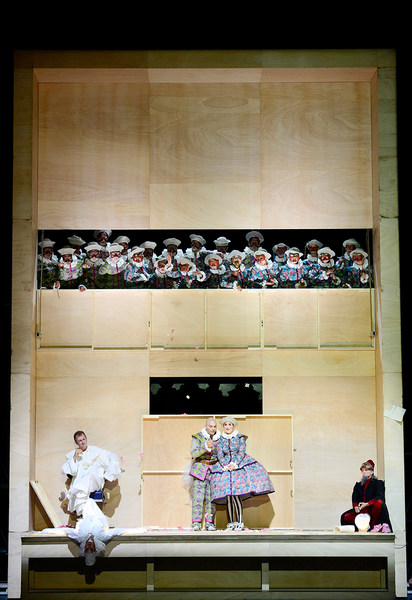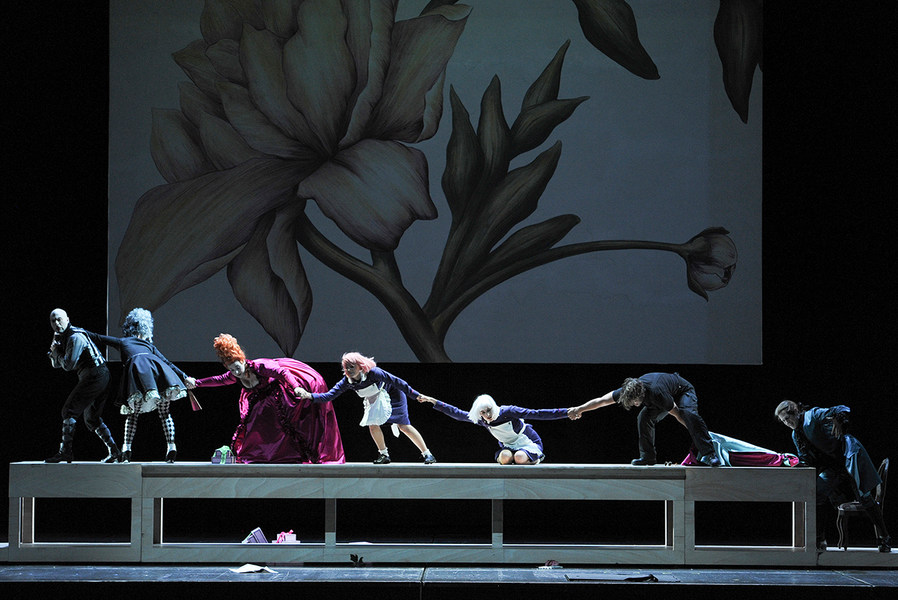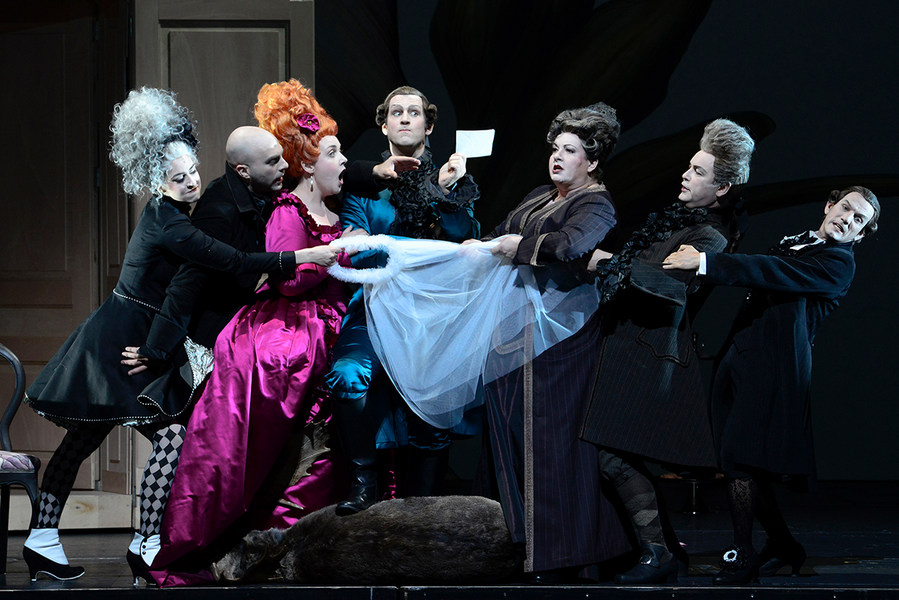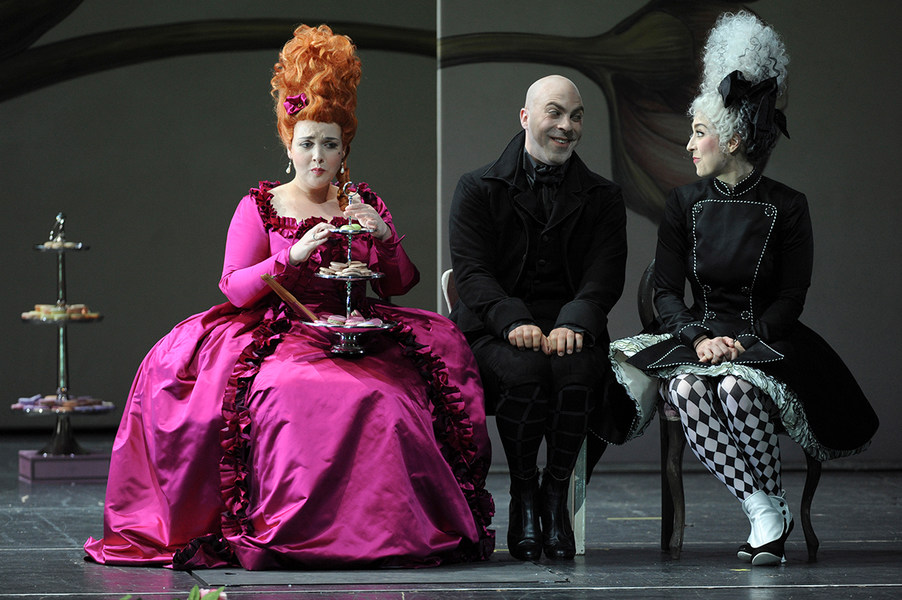A world in turmoil: Mozart’s masterpiece takes us on an emotional and theatrical rollercoaster ride.
Opera buffa in four acts
Libretto by Lorenzo Da Ponte after the play „La folle journée ou le Mariage de Figaro“ by Pierre Augustin Caron de Beaumarchais
Performed in Italian with German and English supertitles
Premiere
20. June 2015
In brief
The wedding of the servant couple Figaro and Susanna is imminent, and everything could be so wonderful, if it weren’t for the lecherous Count Almaviva, who has been stalking Susanna for some time, as well as the vengeful Doctor Bartolo and his housekeeper Marcellina, who all wish to prevent the wedding. After numerous twists and turns, Figaro and Susanna, with the help of the Countess and thanks to an ingenious plan of revenge, finally succeed in thwarting Almaviva using his own art of seduction so that, in the end, all couples are reunited. Wolfgang Amadeus Mozart’s „The Marriage of Figaro“, which premiered at Vienna’s Hoftheater in 1786, is the first of the three Mozart-da Ponte operas. Despite its quick-fire comedic action, the work foreshadows some of the radical ideas of the French Revolution. In his staging, director Johannes Erath takes the audience on a journey through the different epochs of theatrical history from Commedia dell’arte to the modern age.
Storyline
Act 1
Figaro and Susanna want to get married. However, they first need the Count’s permission. The Count has indeed promised his consent, but is still persistently making advances towards Susanna, trying in every way possible to bed her before she gets married to Figaro. The Count would even be willing to pay to achieve this. Marcellina and Bartolo also want to take a swipe at Figaro and are likewise attempting to prevent the wedding. Marcellina would like to get married to the much younger Figaro herself. She even has a hold on him: she once granted a loan to Figaro with the condition that he had to marry her if he should default on the debt.
That morning the Count had discovered Cherubino, the young page, with Barbarina, the gardener’s daughter. Because of this he is to be removed from office. Cherubino goes to Susanna to ask her to persuade the Countess to be his advocate, and there, of all places, he is again found by the Count. The Count is furious. However, he finally allows imself to be persuaded not to dismiss Cherubino but instead to dispatch him as an officer to the Count’s regiment that is deployed far away. He is supposed to leave immediately.
Act 2
The Countess knows that her husband is a skirt-chaser. She conspires with Susanna and Figaro to set a honey trap for him. She intends to expose his infidelity, make him publicly confess and then return to her. To start with, to make him more jealous, he is to be told anonymously about an alleged affair that his wife is having. Then he is to be lured to a rendezvous with Susanna, to which, however, not Susanna herself will be going, but Cherubino, disguised as a young woman. At this tryst the Countess intends to expose her husband. For this reason they are dressing Cherubino in women’s clothes, but are surprised by the Count and hide the young man behind a door. The Count smells a rat and wants to force the door open. To everyone’s surprise, after fetching the appropriate tools, he can only find Susanna behind the door. She had let Cherubino escape, who had then jumped straight out of the window. But the gardener Antonio had seen someone jump and drop a document. Figaro wrongly testifies that he himself, in shock, had jumped out of the window and accidentally lost the paper. With the women’s help he identifies the document as Cherubino’s officer’s appointment. Figaro claims Cherubino had given him the paper since a certain seal was missing on it. Marcellina and Bartolo eventually bring about the denouement of this embarrassing scene by bursting in and demanding a judicial validation of Marcellina’s marriage claim towards Figaro.
Act 3
The countess and Susanna are slightly modifying their scheming plan. Instead of Cherubino dressed up as a woman, the Countess herself, disguised as Susanna, will now go to the rendezvous with the Count. In this way the Count can be caught red-handed in an escapade by the Countess herself. Meanwhile it has been confirmed that Marcellina’s charges against Figaro are justified, which is why Susanna wants to bail out Figaro. Then suddenly Marcellina and Bartolo realise, from what Figaro is saying and from a distinctive birthmark on his arm, that Figaro is in fact their long-lost illegitimate son, who had been abducted from them as a child. Thus, Marcellina and Bartolo also want to get married now, and acknowledge Figaro as their own son.
The Countess dictates to Susanna the letter to summon the Count to the rendezvous. She fastens the letter with a hair pin. The Count is supposed to have the pin returned as a token of his agreement to the date. At the celebration for the announcement of the upcoming double wedding Susanna slips the letter into the Count’s hands. Cherubino also joins in the celebration, disguised as a young woman. However, he is found out by the Count. Figaro observes the Count reading a letter and paying careful attention to a certain pin. Figaro suspects what is going on.
Act 4
In the evening Figaro is lying in wait in the garden. He has learned from Barbarina, who was supposed to return the pin to Susanna, that that is where the encounter of his bride with the Count will take place. But Susanna and the Countess have dressed themselves up in such a way that someone could, in the twilight, assume that the Countess is Susanna whilst mistaking Susanna for the Countess.
First Cherubino falls for the disguise as he tries to kiss the Countess, mistaking her for Susanna. Then the Count presents his wife, whom he also takes for Susanna, with a brilliant ring as a reward for the expected sexual encounter. When Figaro makes himself known, the Countess, playing Susanna, has to hide. Susanna, pretending to be the Countess, meets Figaro. He recognises her by her voice but pretends to fall for the fraud and starts to flirt with her. This is spied by the Count who has been vainly looking for Susanna in the darkness. Furious, he confronts the couple, but then realises that the woman is Susanna. Meanwhile his wife comes out of hiding. She presents him with the brilliant ring as proof of his infidelity and thus forces him to deliver a public declaration of his remorse. She accepts his apologies. Everyone is satisfied.













